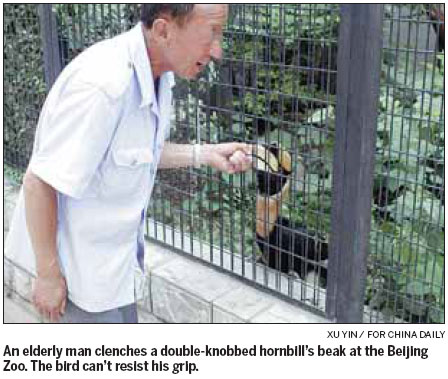A new zoo worldview
Updated: 2013-11-24 07:43
By Xu Lin, Han Bingbin and Luo Wangshu(China Daily)
|
|||||||
Chinese zoos and safari parks are struggling to move beyond abuse-for-profit and toward education-for-conservation. Xu Lin, Han Bingbin and Luo Wangshu report.
A peacock's tail is seemingly fastened to a wooden rack, its feathers forced into a constant fan. A crocodile is tied to a table, its jaw bundled shut with tape. A lion lies in a pit of garbage. Such scenes are appearing more frequently in media accounts of some zoos across the world's most populous nation. Chinese media have shown certain zoos in the country mistreat animals for profit. In September, such domestic media outlets as Beijing Morning Post reported the Beijing Wildlife Park had affixed a peacock to a wooden rack to force its tail to unfurl. Media reported the zoo charged $2.50-$10 per photo.
The park denies it forced the peacock's tail open and says, without elaborating, it instead used a fake tail. It does, however, admit to having taped shut the baby crocodile's mouth, citing visitors' safety. Officials apologized for their actions.
Media also reported in October that Beijing Badaling Wildlife World - the capital's other wildlife park - attached a fake tail to a peacock.
The exposure of zoo animals being used in such ways has sparked traditional and social media reproach.
But it's not only zoos' managers. Accounts of patrons abusing animals have also incurred outrage.
Accusations of visitors mistreating animals at the Hangzhou Zoo surfaced in July. A Web user posted: "I brought my kids to the Hangzhou Zoo's lion park. We saw one lion lying in trash."
Central Institute of Socialism professor Mang Ping is an animal welfare activist focused on the relationship between animals and humans.
Mang's research has found that, since the 1993 opening of China's first safari park - a conservancy in which animals roam uncaged and visitors view them from vehicles - public awareness of animal abuse in these places has grown. Still, the situation has perhaps improved over the past decade.
The worst offenders, Mang says, are animal performances.
Zoos and safari parks have been building more animal performance halls since 2000, Mang says.
University student Wang Anran volunteers for Mang's zoo observation research by visiting different zoos and parks during holidays to report on treatment.
Wang says government-run zoos tend to better protect animals.
"Kids love animal performances because they're like children's stories," Wang says. "They create positive impressions of animals because the creatures behave like humans."
Wang became a volunteer because he recalls witnessing a small bear being mistreated as a child.
He recalls a recent visit to the Beijing Zoo during the National Day Golden Week in which he saw a 2-month-old monkey in a diaper in a small cage. The primate seemed terrified as people teased it and laughed at its fear.
"It's weird," Wang says.
"People enjoy watching animal performances. But it's absurd, if you really think about it. Awareness is growing about family pets' welfare but not about wild animals'."
Some establishments have responded to criticism by highlighting their protection and conservation roles.
Beijing Wildlife Park chief engineer Liu Xinchen says anger toward zoos and safari parks comes from bias.
Reports about coercive performances are exaggerated, Liu says.
"They're animals. We can't change that no matter what we do," Liu says.
"We can't evaluate them using human perspectives."
Chinese Association of Zoological Gardens general department director Yu Zeying says abuse issues are about how people perceive animals. She believes perceptions must change.
"People previously saw zoos as entertainment," Yu says.
"Humans had a master-and-slave relationship with animals in which people ruled absolutely. But zoos now play a different role - that of animal preservation and public education."
The modern zoo concept of species preservation and education is relatively new in China. Previously, wild animals were hunted and brought to zoos. Now, zoos breed and share specimens.
Yu says the modern Chinese zoo should function as a research center where people can learn about animals.
Nanjing Hongshan Forest Park department head Bai Yali says the zoo uses animals to educate visitors and humanize animals.
Her park offers monkey performances in which visitors interact with the primates to learn what they eat. This engagement humanizes the monkeys and establishes a closer interspecies relationship, she says.
Yunnan Wild Animal Park is also enhancing wildlife education.
The park offers kids' classes and actively discourages improper visitor behavior, the park's deputy general manager Yang Chun says.
"Zoos' roles and responsibilities have transformed," Yang says.
"They were a place to watch animals. They've become wildlife education bases."
Contact the writers through xulin@chinadaily.com.cn
Eric Jou contributed to this story.


(China Daily 11/24/2013 page1)